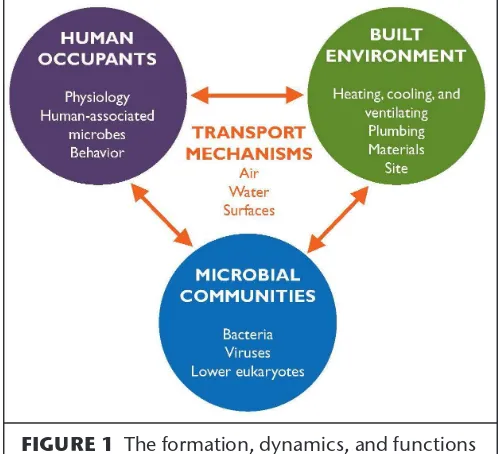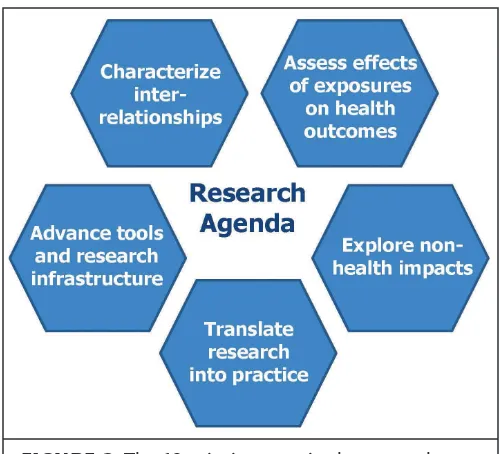Consensus Study Report
HigHligHtS
Microbiomes of the Built Environment
A Research Agenda for Indoor Microbiology, Human
Health, and Buildings
People in developed countries spend the vast majority of their lives indoors. That time is shared with a large and diverse community of microorganisms that ind their way into homes, workplaces, schools, and other buildings via the air that enters intentionally through ventilation and unintentionally through inil-tration; water transported through plumbing or by leaks; and people, animals, plants, and pests, who harbor microbes or track them indoors. Research on indoor environments, microorganisms, and human health has been conducted for decades, but new molecular tools and collaborative efforts that bridge microbiology, engineering, architecture, and public health are generating a deeper understanding of the complex interactions among human occupants, built environments, and associated microbial communities—illustrated in Figure 1 (page 2). This report assesses the current state of this knowledge, iden-tiies knowledge gaps, and outlines a research agenda for illing these gaps and advancing a vision of the future in which buildings can be designed and oper-ated to better support occupant health, improve the sustainability of building systems and materials, and lower energy usage.
HEALTH IMPACTS OF INDOOR MICROBIAL EXPOSURES
The relationship between microbiomes found in built environments and human health is complex, and entails beneicial, neutral, and harmful exposures. Health effects are dependent on factors including the speciic microorganisms pres-ent, the route of exposure, the stage of life or health status of the person being exposed, the potential inluence of co-exposures to indoor
chemicals and particles, and characteristics of the built envi-ronment such as its temperature and humidity.
A number of studies have explored the transmission of pathogens in buildings; familiar examples include inluenza virus and Legionella bacteria. Inluenza can be transmit-ted by contact with door knobs, faucet handles, and other objects that have been contaminated by an infected person, while Legionella can be sustained and ampliied on wetted surfaces and in plumbing systems. Exposure to indoor micro-organisms and their constituent parts also are associated
August 2017
with non-infectious respiratory health impacts in building occupants. Decades of research has shown that exposure to damp, water-damaged buildings results in negative respiratory health.
On the other hand, recent research demonstrates that exposures in early life to microorganisms found on pets, on livestock, or in traditional farm-type environments are associated with a reduction in allergy and respiratory disease. Such exposures may be beneicial to the developing immune system or may arise as a result of other biologic mechanisms that remain to be clariied.
To understand the associations between micro-bial exposures in built environments and diverse health impacts there is a need for longitudinal human studies and complementary laboratory and animal-model investigations, as well as studies to test the effects of speciic changes or interventions hypothesized to alter microbial exposures and affect health outcomes. Public health researchers can play important roles in collaborating with scientiic and engineering disciplines and with professional communities of practice to generate these new hypotheses and design studies to understand the underlying causes of observed effects.
EFFECTS OF BUILDING CHARACTERISTICS
ON MICROBIAL COMMUNITIES
The composition and viability of indoor microbial communities are determined largely by the charac-teristics of the buildings they inhabit, including the availability of water and nutrients for growth and survival, the buildings’ occupants, and the external environment. These relationships affect microbial transport and removal and inluence the formation of indoor microbial reservoirs in air and water, and on surfaces.
Air can enter buildings through intentional ventila-tion (either mechanical—via heating, ventilaventila-tion, and air conditioning (HVAC) systems—or natural, via windows and doors) and through unintentional ventilation—iniltration through small gaps in the building envelope. Mechanical ventilation sys-tems may be outitted with iltration syssys-tems that capture some microorganisms, and air iltration is generally regarded as promoting good health and well-being. Additional research is needed, however, on such topics as the potential beneits of allowing increased introduction of outdoor air in buildings in locations where outdoor pollution levels are relatively low and the ambient temperature is com-fortable for occupants.
Plumbing systems are reservoirs for microbes as is water unintentionally introduced through conden-sation, leaks, or malfunctioning equipment. Much is
known about how to manage water systems within buildings but health issues can still arise. System characteristics such as water temperature affect the viability of microbes, while human behaviors such as leaving a toilet seat up or down while lushing inluence exposure to microorganisms that become aerosolized and may thus have an impact on human health. Microbial growth in buildings also can affect building materials, resulting in corrosion or degra-dation, and affect building systems, such as when bioilms foul HVAC components.
Moving the ield forward will require a better understanding of how building attributes inlu-ence microbial communities. Future research would greatly beneit from the systematic collection of a common set of data on building attributes and indoor environmental conditions so that these factors may be taken into account and examined across studies.
TOOLS TO FACILITATE ANALYSIS
The investigation of indoor microbiomes relies on a number of tools and data collection strategies to capture the dynamics involved. Sensors to measure and monitor such building characteristics as tem-perature, moisture, and airlow should be included, along with more attention to occupant activities and behaviors. Means for characterizing which micro-organisms are present in samples collected from air iltration systems, showerheads, carpeting, and the like need to be coupled to those that describe microbial functions to provide a more comprehen-sive understanding.
Since relatively few microorganisms can be cul-tured, molecular techniques including genomics, proteomics, and metabolomics are increasingly important tools for assessing the composition and activities of microbial communities. Advances in the research infrastructure that underpins the micro-biome-built environment ield, particularly additional community efforts to develop standards and bench-marks that facilitate the comparison of results from across different studies, and expanded data sharing and data analysis platforms, will be critical.
INTERVENTIONS IN THE BUILT
ENVIRONMENT
Potential interventions to improve indoor envi-ronmental quality in buildings, both in reducing exposure to harmful microbes and possibly in facili-tating exposure to beneicial microbes, are available. For example, buildings that have well-designed ventilation systems provide better means to control microbial exposures than buildings ventilated by unintentional air leakage. Changes to cleaning prod-ucts and cleaning routines are another area where interventions can inluence the composition and viability of indoor microbial communities, affecting potential adverse or beneicial exposures.
The use of quantitative frameworks to model proposed interventions can provide insights into
tradeoffs among potentially competing priorities. Such frameworks as building airlow and contami-nant transport models, risk analyses, and building energy models can be used to anticipate the effects of interventions. Connecting this information with additional infrastructure design and occupant health data can aid in the design of alternative approaches and inform further development.
1. Understand relationships among building site selection, design, construction, commissioning, operation, and maintenance; building occupants; and microbial communities;
2. Incorporate social and behavioral sciences to analyze the roles of the people in the built environment;
3. Use complementary study designs--observational, animal model, and intervention—to develop and test health-speciic hypotheses;
4. Clarify effects of timing (stage of life), dose, and differences in human sensitivity on relationships among microbial exposures and health;
5. Develop exposure assessment approaches to address how combinations of exposures (micro-bial agents, chemicals, and physical materials) inluence human functional responses and health outcomes;
6. Understand energy, environmental, and eco-nomic impacts of interventions that modify microbial exposures and integrate data into frameworks for assessing potential interventions;
Box 2
Recap of Research Agenda
7. Reine molecular tools and methods for elucidat-ing identity, abundance, activity, and functions of the microbial communities to enabling more quantitative, sensitive, and reproducible experi-mental designs;
8. Reine building and microbiome sensing and monitoring tools;
9. Develop guidance on sampling and exposure methods for testing microbiome–built environ-ment hypotheses;
10. Develop a data commons with data description standards and provisions for data storage, sharing, and knowledge retrieval;
11. Develop empirical, computational, and mecha-nistic modeling tools to improve understanding, prediction, and management;
12. Support effective communication and engage-ment to convey microbiome–built environengage-ment information to audiences including professional building design, operation, and maintenance communities; clinical practitioners; and building occupants and homeowners.
Copyright 2017 by the National Academy of Sciences. All rights reserved.
For More Information . . . This Consensus Study Report Highlights was prepared by the National Academies of Sciences Engineering, and Medicine, based on the Consensus Study Report Microbiomes of the Built Environment: A Research Agenda for Indoor Microbiology, Human Health, and Buildings (2017). The study was sponsored by the the Alfred P. Sloan Foundation, Gordon and Betty Moore Foundation, National Aeronautics and Space Administration, National Institutes of Health, U.S. Environmental Protection Agency, and National Academy of Sciences Cecil and Ida Green Fund.. Any opinions, indings, conclusions, or recommendations expressed in this publication do not necessarily relect the views of any organization or agency that provided support for the project. Copies of the Consensus Study Report are available from the National Academies Press, (800) 624-6242; http://www.nap.edu or via the Board on Life Sciences web page at http://www. nationalacademies.org/bls.
COMMITTEE ON MICROBIOMES OF THE BUILT ENVIRONMENT: FROM RESEARCH TO
APPLICATION
Joan Wennstrom Bennett (Chair), Rutgers University; Jonathan Allen, Lawrence Livermore National Laboratory; Jean Cox-Ganser, National Institute for Occupational Safety and Health; Jack Gilbert, University of Chicago; Diane Gold, Brigham and Women’s Hospital, Harvard Medical School, and Harvard T.H. Chan School of Public Health; Jessica Green, University of Oregon; Charles Haas, Drexel University; Mark Hernandez, University of Colorado Boulder; Robert Holt, University of Florida; Ronald Latanision, Exponent; Hal Levin, Building Ecology Research Group; Vivian Loftness, Carnegie Mellon University;
Karen Nelson, J. Craig Venter Institute; Jordan Peccia, Yale University; Andrew Persily, National Institute of Standards and Technology; Jizhong Zhou, University of Oklahoma; Katherine Bowman (Board on Life Sciences [BLS]), Elizabeth Boyle (Board on Environmental Studies and Toxicology), David A. Butler, Scholar, Health and Medicine Division, Andrea Hodgson (BLS), Jenna Ogilvie (BLS), Cameron Oskvig
(Board on Infrastructure and the Constructed Environment), Proctor Reid (National Academy of Engineering Program Ofice), Frances Sharples (BLS)
Division on Earth and life Studies
Division on Engineering and Physical Sciences
Health and Medicine Division
National Academy of Engineering
A RESEARCH AGENDA FOR ACHIEVING
THE VISION
Although past research has yielded exciting clues to understand the interconnections among built environments, microbial communities, and humans, many open questions remain. A systematic effort will be required to achieve a vision in which these interactions can be predicated and managed so as to design, operate, and maintain more healthful build-ings. The accomplishment of this vision will require integrating expertise from many scientiic, health and engineering disciplines along with professional

